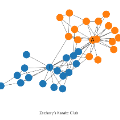Heterogeneous information networks (HINs) are widely employed for describing real-world data with intricate entities and relationships. To automatically utilize their semantic information, graph neural architecture search has recently been developed on various tasks of HINs. Existing works, on the other hand, show weaknesses in instability and inflexibility. To address these issues, we propose a novel method called Partial Message Meta Multigraph search (PMMM) to automatically optimize the neural architecture design on HINs. Specifically, to learn how graph neural networks (GNNs) propagate messages along various types of edges, PMMM adopts an efficient differentiable framework to search for a meaningful meta multigraph, which can capture more flexible and complex semantic relations than a meta graph. The differentiable search typically suffers from performance instability, so we further propose a stable algorithm called partial message search to ensure that the searched meta multigraph consistently surpasses the manually designed meta-structures, i.e., meta-paths. Extensive experiments on six benchmark datasets over two representative tasks, including node classification and recommendation, demonstrate the effectiveness of the proposed method. Our approach outperforms the state-of-the-art heterogeneous GNNs, finds out meaningful meta multigraphs, and is significantly more stable.
翻译:在描述与复杂实体和关系的真实世界数据时,广泛使用异质信息网络(HINs)来描述与复杂实体和关系相关的真实世界数据。为了自动利用其语义信息,最近针对HINs的各种任务开发了图形神经结构搜索。另一方面,现有的作品显示不稳定性和不灵活方面的弱点。为了解决这些问题,我们提议了一种叫作部分信息元数据多式搜索(PMMM)的新颖方法,以自动优化HINs上的神经结构设计。具体地说,为了了解图形神经网络(GNNs)如何在各种边缘传播信息,MMM采用了一个高效的可区别框架,以寻找一种有意义的元多面图,能够捕捉出比元图更灵活和复杂的语义关系。不同的搜索通常受到性能不稳定的影响。因此我们进一步提出一种稳定的算法,称为部分信息搜索,以确保搜索的元数据始终超过人工设计的元结构,即元数据路径。关于六个基准数据集的大规模实验,包括节点分类和建议,展示了拟议方法的效能。我们的方法比GNMMM要大大地超越G的多元性。





